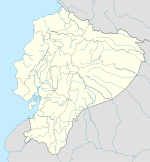Picoazá
Location in Ecuador |
Picoazá is a parish in Portoviejo in the Ecuadorian province of Manabí . The municipality is located in the area of pre-Columbian settlements and attracted worldwide attention in the course of a political election in 1967. Picoazá today has 20,000 inhabitants.
description
Picoazá is located at 40 m on the Río Portoviejo around 5 km northwest of the center of the provincial capital of the same name . The Pacific coast with the Bahia de Jaramijó is about 16 km away. This part of the province of Manabi is famous for its cuisine and its coral trees of the species Erythrina crista-galli known which are unique to the region. Picoazá itself is a commercial sub-center and sells agricultural products and other consumer goods. The water supply turns out to be problematic and not very reliable. The US non-profit organization Hands for Humanity certified thisDrinking water of the community in 2008 an unsafe condition and suggested an investigation of the sediment-rich river water.
history
Archaeological finds from 2008 suggest that the Picoazá area is pre-Columbian settlement. In 1907, the second archaeological expedition explored Marshall Howard Saville the caves around Picoazá and in particular the 5 km from the city settlements Cerro Jaboncilla and Cerro de Hojas away. Some significant artifacts were found . Early colonial sources indicate that Picoazá was once the chiefdom of the Manteño Guancavilca culture and contained masses of characteristic Manteño ceramics and large stone foundations. It was divided into four settlements with a liege lord in the main settlement. In the meantime part of a quarry , the archaeological site was declared a national cultural heritage in 2009. In 2017, a museum dedicated to the pre-Columbian population opened in Hojas Jaboncillo.
The city of Portoviejo , to which Picoazá belongs today, was founded on March 12, 1535 by the conquistador Francisco Pacheco. In 1838, when the Diocese of Guayaquil was founded, Picoazá was named an independent parish and the city was first named in a bull . In 1880, 2000 citizens applied for their own curate and the parish split off from the one in Portoviejo. In 1884 the residents of Picoazá under General Eloy Alfaro were involved in fighting against government troops.
politics
Picoazá hit the international headlines as a result of the nationwide local elections in July 1967. A company ran a series of advertisements for a foot powder called Pulvapies as part of a campaign . One of the slogans was "Choose a candidate, but if you want wellbeing and hygiene, choose Pulvapies ". An elegantly dressed fictional figure with a foot for a head advertised with the slogan "To the mayor: The honorable Pulvapies ". Although not an official candidate, Pulvapies surprisingly emerged as the winner of the election. United Press International later put into perspective that reports that the foot powder had been elected mayor of the city of 4,000 inhabitants were untrue. Had been elected local councils and not the mayor. The problem arose from the nationwide distribution of leaflets that looked exactly like the official ballot papers. An estimated 10,000 of them would have found their way into the ballot boxes, mostly in Quito and Guayaquil . After political competitors filed complaints, the false ballots were eventually invalidated.
Web links
Individual evidence
- ↑ Jenny Jovita's story. kiva.org, accessed October 12, 2017 .
- ↑ Jeff Hansel: 100 Hands - Humanitarian effort reaches milestone. Post Bulletin, February 6, 2008, accessed October 12, 2017 .
- ^ Helaine Silverman & William H. Isbell (Eds.): Handbook of South American Archaelogy. Springer , New York 2008, p. 512. ISBN 978-0-387-75228-0 . Reading sample (English).
- ↑ a b Peter N. Peregrine & Melvin Ember (eds.): Encyclopedia of Prehistory. Volume 5. Middle America. Springer , New York 2001, p. 307. ISBN 978-0-306-46259-7 (English).
- ↑ ibid., P. 320.
- ↑ Mariella Toranzos: La cultura manteña guarda su legado en un nuevo hogar. expreso.ec, March 4, 2017, accessed October 12, 2017 (Spanish).
- ↑ Picoazá - Historia. picoaza.com, accessed October 12, 2017 (Spanish).
- ↑ Foot Powder Produces Headaches in Ecuador. The New York Times , July 17, 1967, accessed October 12, 2017 .
- ↑ Foot Powder Ecuador Election Result. snopes.com, accessed October 12, 2017 .
- ↑ Chicago Tribune , July 18, 1967, p. 3.
- ↑ Ad Campaign for Foot Powder Stirs Trouble. Minneapolis Star Tribune , July 20, 1967 issue, p. 27.
- ↑ Honorable Pulvapies, Talcos para pies. Pulvapies, March 16, 2016, accessed October 21, 2017 (Spanish).
Coordinates: 1 ° 2 ′ 8.7 ″ S , 80 ° 29 ′ 34.8 ″ W.

